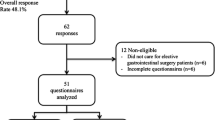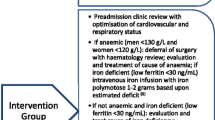Abstract
Five hundred orthopaedic surgeons and 336 anaesthetists were surveyed to assess current UK attitudes towards transfusion practice following arthroplasty surgery. Seventy-two percent of surgeons and 73% of anaesthetists responded to the survey. In an uncomplicated patient following total hip arthroplasty, 53.2% of surgeons and 63.1% of anaesthetists would transfuse at or below a haemoglobin (Hb) level of 8 g/dL. Surgeons tended to be more aggressive in their attitudes, with a mean transfusion threshold of 8.3 g/dL compared to 7.9 g/dL for anaesthetists (p < 0.01), and with 97% of surgeons transfusing two or more units compared to 78% of anaesthetists (p < 0.01). This threshold Hb increased if the patient was symptomatic (surgeons 9.3 g/dL, anaesthetists 8.8 g/dL, p < 0.05) or was known to have pre-existing ischaemic heart disease (surgeons 9.0 g/dL, anaesthetists 9.2 g/dL, p < 0.05). A wide variability in attitudes and practices is demonstrated, and the development and adoption of consensus guidelines needs to be encouraged if efforts to reduce the use of blood products are to succeed.
Résumé
Cinq cent chirurgiens orthopédiques et 336 médecins anesthésistes ont participé à une enquête permettant de déterminer quelles étaient les pratiques de transfusion au Royaume-Uni en chirurgie arthroplastique. Soixante douze pour cent des chirurgiens, 73% des anesthésistes ont répondu à cette enquête après avoir réalisé une arthroplastie sans complication chez un patient. 53,2% des chirurgiens et 63,1% des anesthésistes n’ordonnent une transfusion que si le taux d’hémoglobine est inférieur ou égal à 8 g/dL. Les chirurgiens ayant une tendance plus agressive quant à la transfusion à partir de 8,3 g/dL d’hémoglobine au lieu de 7,9 g/dL pour les anesthésistes (p < 0,01). La transfusion est alors de deux unités pour 97% des chirurgiens alors que seulement 78% des anesthésistes en éprouvent le besoin (p < 0,01). Le taux d’hémoglobine limite pour une transfusion augmente si le patient est symptomatique (9,3 g/dL d’hémoglobine pour les chirurgies, 8,8 g/dL pour les anesthésistes, p < 0,05) ou s’il a existé des problèmes de cœur ischémique au niveau cardiaque (chirurgiens 9,0 g/dL d’hémoglobine, anesthésistes 9,2 g/dL, p < 0,05). Il existe de ce fait une grande variété d’attitude dans les pratiques de la transfusion et ceci nous encourage à adopter un consensus avec des règles bien précises de façon à réduire la quantité de sang à transfuser.



Similar content being viewed by others
References
Adams RC, Lundy JS (1942) Anesthesia in cases of poor surgical risk: some suggestions for decreasing the risk. Surg Gynecol Obstet 74:1011–1019
Busch MP, Kleinman SH, Nemo GJ (2003) Current and emerging infectious risks of blood transfusions. JAMA 289(8):959–962
Carson JL, Duff A, Berlin JA, Lawrence VA, Poses RM, Huber EC, O’Hara DA, Noveck H, Strom BL (1998) Perioperative blood transfusion and postoperative mortality. JAMA 279(3):199–205
Carson JL, Duff A, Poses RM, Berlin JA, Spence RK, Trout R, Noveck H, Strom BL (1996) Effect of anaemia and cardiovascular disease on surgical mortality and morbidity. Lancet 348(9034):1055–1060
Carson JL, Terrin ML, Barton FB, Aaron R, Greenburg AG, Heck DA, Magaziner J, Merlino FE, Bunce G, McClelland B, Duff A, Noveck H (1998) A pilot randomized trial comparing symptomatic vs. hemoglobin-level-driven red blood cell transfusions following hip fracture. Transfusion 38(6):522–529
Hebert PC, Fergusson DA, Stather D, McIntyre L, Martin C, Doucette S, Blajchman M, Graham ID; Canadian Critical Care Trials Group (2005) Revisiting transfusion practices in critically ill patients. Crit Care Med 33(1):7–12
Hebert PC, Wells G, Blajchman MA, Marshall J, Martin C, Pagliarello G, Tweeddale M, Schweitzer I, Yetisir E; Canadian Critical Care Trials Group (1999) A multicenter, randomized, controlled clinical trial of transfusion requirements in critical care. N Engl J Med 340(6):409–417
Helm AT, Karski MT, Parsons SJ, Sampath JS, Bale RS (2003) A strategy for reducing blood-transfusion requirements in elective orthopaedic surgery. Audit of an algorithm for arthroplasty of the lower limb. J Bone Joint Surg 85(4):484–489
Kendall SJ, Weir J, Aspinall R, Henderson D, Rosson J (2000) Erythrocyte transfusion causes immunosuppression after total hip replacement. Clin Orthop Relat Res 381:145–155
Lawrence VA, Silverstein JH, Cornell JE, Pederson T, Noveck H, Carson JL (2003) Higher Hb level is associated with better early functional recovery after hip fracture repair. Transfusion 43(12):1717–1722
Matot I, Einav S, Goodman S, Zeldin A, Weissman C, Elchalal U (2004) A survey of physicians’ attitudes toward blood transfusion in patients undergoing cesarean section. Am J Obstet Gynecol 190(2):462–467
Muller U, Exadaktylos A, Roeder C, Pisan M, Eggli S, Juni P (2004) Effect of a flow chart on use of blood transfusions in primary total hip and knee replacement: prospective before and after study. BMJ 328(7445):934–938
Murphy MF, Wallington TB, Kelsey P, Boulton F, Bruce M, Cohen H, Duguid J, Knowles SM, Poole G, Williamson LM (2001) British committee for standards in haematology, blood transfusion task force. Guidelines for the clinical use of red cell transfusions. Br J Haematol 113(1):24–31
Nuttall GA, Stehling LC, Beighley CM, Faust RJ (2003) American society of anesthesiologists committee on transfusion medicine. Current transfusion practices of members of the American Society of Anesthesiologists: a survey. Anesthesiology 99(6):1433–1443
Rosencher N, Kerkkamp HE, Macheras G, Munuera LM, Menichella G, Barton DM, Cremers S, Abraham IL (2003) OSTHEO investigation. Orthopedic surgery transfusion hemoglobin European overview (OSTHEO) study: blood management in elective knee and hip arthroplasty in Europe. Transfusion 43(4):459–469
Spencer J, Thomas SR, Yardy G, Mukundan C, Barrington R (2005) Are we overusing blood transfusing after elective joint replacement? A simple method to reduce the use of a scarce resource. Ann R Coll Surg Engl 87(1):28–30
Stanworth SJ, Cockburn HAC, Boralessa H, Contreras M (2002) Which groups of patients are transfused? A study of red cell usage in London and southeast England. Vox Sanguinis 83(4):352
Torella F, Haynes SL, Lardi A, O’Dwyer ST, McCollum CN (2001) Unchanging attitudes to autologous transfusion in the UK. Transfus Med 11(1):15–19
Acknowledgement
This paper was funded by a grant from the Royal National Orthopaedic Hospital Research Trust.
Author information
Authors and Affiliations
Corresponding author
Rights and permissions
About this article
Cite this article
Young, S.W., Marsh, D.J., Akhavani, M.A. et al. Attitudes to blood transfusion post arthroplasty surgery in the United Kingdom: A national survey. International Orthopaedics (SICO 32, 325–329 (2008). https://doi.org/10.1007/s00264-007-0330-0
Received:
Revised:
Accepted:
Published:
Issue Date:
DOI: https://doi.org/10.1007/s00264-007-0330-0




